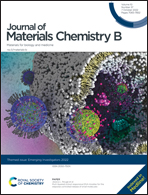Fluidic enabled bioelectronic implants: opportunities and challenges
Abstract
Bioelectronic implants are increasingly facilitating novel strategies for clinical diagnosis and treatment. The integration of fluidic technologies into such implants enables new complementary routes for sensing and therapy alongside electrical interaction. Indeed, these two technologies, electrical and fluidic, can work synergistically in a bioelectronics implant towards the fabrication of a complete therapeutic platform. In this perspective article, the leading applications of fluidic enabled bioelectronic implants are highlighted and methods of operation and material choices are discussed. Furthermore, a forward-looking perspective is offered on emerging opportunities as well as critical materials and technological challenges.

- This article is part of the themed collections: Journal of Materials Chemistry B Emerging Investigators and Journal of Materials Chemistry B Recent Review Articles

 Please wait while we load your content...
Please wait while we load your content...